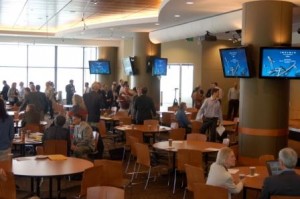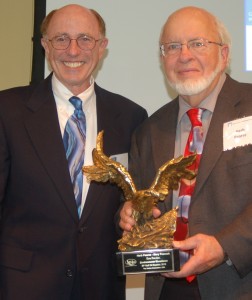 On June 17, 2011, the WCTA sponsored a half day seminar on Growing Cleantech Businesses. This is a synopsis.
On June 17, 2011, the WCTA sponsored a half day seminar on Growing Cleantech Businesses. This is a synopsis.
Follow this link to view many of the presentations: https://9slides.com/channel/WCTA
Foss Maritime uses hybrid technology to create tugboats that can do what ordinary tugs cannot: They consume 25% less fuel, have more safety features, and require less maintenance than the standard tugboat. The hybrid tug’s main engine remains turned off nearly 50% of the time reducing idling pollution. Vice President Susan Hayman of Foss Maritime spoke on behalf of the company about the 2011 hybrid tugs. She reported that the Foss Dolphin tug emits 27% less CO2 than the standard tug model.
Sustainable Aviation Fuels Northwest is a unique collaboration that aims to develop a biofuels industry in the Northwest. John Gardner, WCTA Board member and former Vice President at Washington State University, discussed the SAFN effort. The initiative was launched in July 2010 by Boeing, Alaska Airlines, the Port of Seattle, the Port of Portland, the Spokane International Airport, and Washington State University, a center for advanced biofuels research. Climate Solutions was retained to manage a stakeholder process that included more than 40 organizations ranging across aviation, biofuels production, environmental advocacy, agriculture, forestry, federal and state government agencies, academic research, and technical consultancies. SAFN strives to create sustainable aviation fuels; only the fuels that surpass certain approval standards are used as aviation biofuels.

ADsorb-It, a product developed by Eco-Tec, Inc., removes oil, oil sheen, oil-borne contaminants, and suspended solids. It allows virtually unrestricted water flows. It was extensively deployed to block oil from reaching marshes and beaches in the Gulf of Mexico following the BP oil spill. ADsorb-It was incredibly successful in its deployment across hundreds of miles saving beaches and wetlands (The material was recently pulled out due to its negative impact on tourism in the area). Company president Herb Pearse received an award for his efforts in the Gulf of Mexico oil spill at the WCTA Growing Cleantech Businesses meeting.
Infinia uses Stirling engine technology to generate solar power and requires virtually no maintenance. The PowerDish can be developed quickly and may be used in many different settings. Speaking on behalf of Infinia, Jason Modrell, talked about the company’s recipe for success after two-and-a-half decades in business. He emphasized the importance of companies hiring the right people, including a CEO able to attract investors. By completing the necessary research and knowing the market well, Infinia demonstrated a compelling investment story from the beginning.
Clarian Power‘s SmartBox Solar Module is a plug-in solar panel that’s affordable and easy to install. The technology allows homeowners to plug solar power into an existing outlet without the expense and hassle of larger turn-key systems. SmartBox technology serves as a power source that can integrate wind and solar power that you can plug into a regular home electrical outlet. The SmartBox technology is simple, affordable, and can be used on everything from “fridges to dishwashers, to plug-in solar panels and wind turbines.” Speaker and CEO Chad Maglaque spoke about the difficulties of funding green projects and about the importance of the ability to shift courses in business while staying true to the company’s mission.
Clean Tech Open 2011 Semifinalists
The Pacific Northwest Cleantech Open Semifinalists were announced at the meeting. The Washington state winners were: Clarian Power, GreenSimian, GridMobility, IDEAbuilder, MotoVolta, Mountain Logic, Sky Mill Energy, Versalence, and WISErg. Each semifinalist was asked to give its ‘elevator pitch.”
Follow this link to view the elevator pitches: https://9slides.com/channel/WCTA
- Clarian Power, Seattle (Smart Power/Grid) 2nd-time CTO Winner: There is no automated way to connect and activate the increasing array of ‘smart’ consumer appliances and sync them with the power grid. Clarian’s Device Activation Platform streamlines the connection process, provides a full inventory of devices connected to the utility network with the ability to control and revoke access as devices come online, and is backed by a robust business rules schema. Think VeriSign for smart-grid devices. Clarian Energy Data Service overlays device info with demographic data to identify growth and problem areas in advance with the ability aggregate RECs and green credits. Think Zillow for smart homes and devices.
- GreenSimian, Seattle (Energy Generation/Renewables). Consumers want their phones and tablets to be smart and thin; that equates to power-hungry devices with small batteries. GreenSimian wants to recharge those devices from available light. The SolCurve platform is a chipset, software and thin-film photovoltaic that can charge lithium batteries in smart phones and other consumer devices.
- GridMobility, Kirkland (Smart Power/Grid): Renewable energy is not always available when consumers need it. GridMobility’s Renewable Demand Response software time-shifts electricity consumption based on renewable electricity delivery. RDR is deployed by the Bonneville Power Administration and a WA State utility in the residential and storage markets and will soon be implemented by major Fortune 500 companies and other utilities nationwide in the commercial, industrial, and EV markets.
- IDEAbuilder, West Seattle (Green Building). IDEAbuilder sees a growing global market for architecturally-compelling, high-performance green buildings. The company’s construction methods use advanced fabrication and modularization systems to make green building more affordable to the mass market. Application of robotic fabrication and real-time design and simulation technologies can allow construction in 1/3 of the time and at lower cost than conventional buildings constructed by traditional building companies – thereby making green building affordable to the mass market.
- MotoVolta, Kent (Transportation): Electric motorcycles have captured the imaginations of people for whom a Nissan Leaf just doesn’t do it. MotoVolta is developing scalable electric powertrain technology for the motorcycle industry. Its first e-cycle promises 600 cc comparable performance. Automobiles have historically been the main focus for alternative energy transportation; however, motorcycles actually generate over 4X more carbon emissions per mile than an SUV. MotoVolta’s proprietary powertrain system is also scalable to use in other applications requiring clean power generation.
- Mountain Logic, Snoqualmie Pass (Green Building): Central forced-air systems heat or cool the whole house as though someone were occupying every room. MountainLogic’s system uses automated dampers and self-programming sensors that learn the patterns of the residents and can cut 50% from the heating/cooling costs of the 80% of US homes that use central forced air HVAC systems. Home owners gain a simple means to control room temperature, conserve energy, and respond to coming smart grid demand response signals for their largest energy usage. The system includes wireless automated airflow dampers and self-programming sensors that learn the patterns of the occupants.
- Sky Mill Energy, Friday Harbor (Energy Generation/Renewables): Wind is the planet’s largest concentrated source of renewable energy, yet 99.9% is above the reach of conventional wind turbines. SkyMill Energy is the only system with the technical capability to reach the ever-powerful JET STREAM winds. Validated by corporate and academic engineers in the US and India, SkyMill’s high altitude tethered rotary-airfoil economically taps this abundant resource. The Asian jet stream winds are stable and strong enough to provide continuous base and peak load power and contain enough harvestable energy to cost effectively supply all India and China’s winter power needs.
- Versalence, Camas (Energy Generation/Renewables): The Dept of Energy has projected that the country could double hydropower with minimal impacts to the environment, in part by installing low-impact turbines. Versalence has developed a system using a floating turbine to generate electricity in free stream flow as low as 3 mph. This system may either be mounted on an expandable, moveable barge in river systems and tidal areas or in a series of concrete pads at the bases of dams, in tail races, and in stable river flows.
- WISErg, Redmond (Energy Generation/Renewables). WISErg’s unique two-phase anaerobic digestion technology uses a community’s own compostable food waste to sustainably produce organic fertilizer and a renewable energy co-product available for real-time use by a co-located natural gas consumer, reducing fossil gas costs and gaining clean energy credit eligibility. WISErg’s model integrates into the existing waste handling process minimizing transportation requirements and they are already engaged with groceries, cities, fertilizer distributors and waste processing firms.
Lunch Panel: The Post-Fukushima Era: Is Nuclear Power a Safe, Green Power Source?
In his nuclear panel presentation, Professor Ken Nash of Washington State University argued that we do indeed need nuclear energy; it is a relatively low-cost and efficient base load source of power. The intermittance of other energy forms such as wind and solar energy require a backup source. Nuclear power currently makes up about fifteen percent of the world’s electricity, a fairly significant percentage. The problem is, as Dr. Nash stated, that not enough research goes into nuclear energy research. The US also has not invested enough time or money in nuclear energy, which might well mitigate safety and other issues. In light of the recent nuclear disaster in Japan, Dr. Nash assured that nuclear plants could be safer if they were more thoroughly regulated and funded by the industry. He says that on a nuclear reactor safety scale of 1-4, current nuclear reactors need to move up to a 4, which has yet to happen.
A respondent panel consisted of Dr. Nash, Jim Harding (Harding Consultants), Steve Otis, PE (University Mechanical Contractors), and Pat Schweiger (TerraPower). It was thoughtfully moderated by Steve Scher, KUOW. Ross MacFarlane (Climate Solutions) was drafted to fill in for a panelist with car trouble. The panel explored additional ideas and offered alternative views on the viability and cost of nuclear power.
See Dr. Nash’s presentation here.